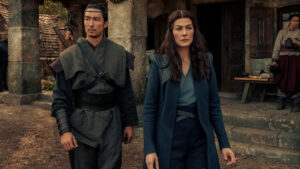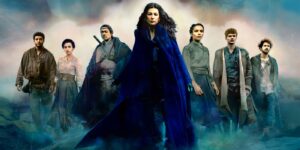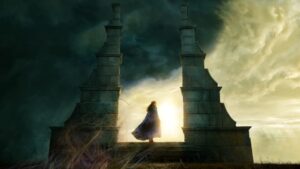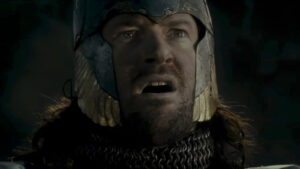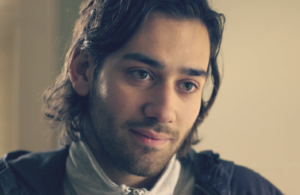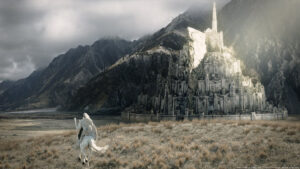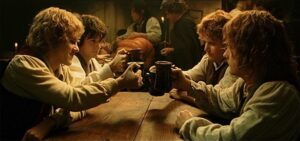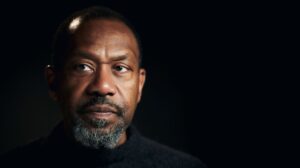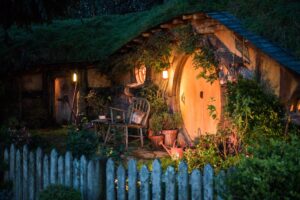SPOILERS FOR THE WHEEL OF TIME EPISODE TWO AHEAD!
With episode four of The Wheel Of Time now out on Amazon Prime, my review of episode two is perhaps, scratch that, definitely, a little bit late. Hopefully I’ll have caught up to the show in time for episode five, but if not, well, it’s my own fault for having too much to say individually about the first three episodes than could be reasonably be crammed into a single super-sized review. What can I say? I geek out over fantasy, and I end up writing way too much about everything down to the tiniest worldbuilding details or bits and pieces of deep lore, and mind you, I wouldn’t even consider myself a diehard fan of The Wheel Of Time books.

I read almost all of them, to be clear, only putting down the series for good shortly after reaching the point where Robert Jordan left off and Brandon Sanderson took over for him. There’s stuff I really like about the books, including their complex storylines and massive ensemble cast set against a backdrop of rich worldbuilding. But then there’s stuff like Jordan’s dry writing style and the sluggish pacing and the sexism built into The Wheel Of Time‘s world and magic system that ultimately led me to stop reading the books.
All of which is to say that there aren’t many changes that the Amazon Prime series could make to the source material that would bother me greatly – at least not on the grounds that “it’s inaccurate, and therefore bad”. When I feel that a change is unnecessary, or negatively impacts the story and character development, I’ll note it, but for the most part I entrust that solemn duty to Wheel Of Time book purists. So be warned that this post will include a lot of raving about episode two, which features some massive changes from the books.
Despite and in large part due to these changes, episode two slowly begins creeping out from under the looming shadow of J.R.R. Tolkien’s influence on the early books in The Wheel Of Time. Where Robert Jordan filled his first book in the series, The Eye Of The World, with intentional pastiches of Tolkien’s characters and locations, showrunner Rafe Judkins has made the wise decision to either cut these derivative stragglers entirely, or swap them out for the products of Jordan’s own genius.
For instance, the characters no longer stay at an inn in the town of Bree, sorry, Baerlon, where in the books they encountered Whitecloaks and a terrifying Myrddraal, and gained a traveling companion in the Wisdom of Emond’s Field, Nynaeve al’Meara (Zoë Robins). Judkins drops the sojourn in Baerlon, scattering the various events that happened there in the books throughout this episode and the rest of the season.
The meeting with Whitecloak zealots therefore takes place on a deserted stretch of road where their threat is more immediate. The characters don’t come face-to-face with a Myrddraal until episode four, prolonging the suspense. And Nynaeve’s eventual reappearance is moved to a later point in the narrative where its consequences and implications are more interesting. All of that allows us to reach one of Jordan’s most iconic locations, the sentient city of Shadar Logoth, much sooner than we did in the books.
Now, there are drawbacks to cutting out this sizable chunk of the story. Obviously, we lose the popular Baerlon-based character of Min Farshaw – although she’ll show up later in the season, so that’s another example of Judkins simply rearranging the pieces of Jordan’s puzzle. More problematically, interactions between the main characters are again reduced to a sprinkling of underwritten scenes in this episode, and the characters split up at the end of the episode. The time we didn’t get to know them is now time we can’t get back.
And if this pivotal event were pushed back just by one episode, perhaps it wouldn’t come across quite as hectic as it does, but this is episode two. We’ve barely even had a chance to connect with the characters individually, and we’re still only just learning about their relationships with each other when suddenly they’re divided off into pairs. The Wheel Of Time is veritably spinning along. But this is truly a fault of episode one, which didn’t lay strong groundwork for the series to build upon.
I only need to cite one example of what I mean by this. By the time that Egwene al’Vere (Madeleine Madden) and Rand al’Thor (Josha Stradowski) break up in episode two, shortly before being forcibly separated at Shadar Logoth, we still have no idea why Egwene’s dream of becoming Nynaeve’s apprentice was so important to her that she would give up Rand to pursue it. The nuances of Egwene trying to repair their relationship in the aftermath of Nynaeve’s apparent death, only to be rejected by a Rand bitter at being manipulated, are simply too complex to be summed up in one or two scenes – which are all this subplot is allotted.
It’s a shame, because what this episode does spectacularly well in a very short time is explore the wide range of emotions towards Moiraine Damodred (Rosamund Pike) from each of the characters she takes on as a ward – particularly Egwene, whose awe develops into reverence and respect for the Aes Sedai after two separate incidents, one at Taren Ferry and the other with the aforementioned Whitecloaks in the woods, that simultaneously alienate Moiraine from her male traveling companions, especially Rand and Mat Cauthon (Barney Harris).

The first of these incidents is a frightening demonstration of an Aes Sedai’s power that leaves an innocent man dead, although as Moiraine points out very reasonably afterwards she didn’t kill him directly, and to say that she did would be a grave accusation as an Aes Sedai is forbidden to use the One Power as a weapon “except against Darkfriends or Shadowspawn, or in the last extreme defense of her life, the life of her Warder, or another Aes Sedai”. Such subtleties are lost on Mat, who develops a fear for Moiraine that manifests itself in irrational outbursts.
In the instinctive reactions of Mat and Rand to Moiraine’s power and secrecy, it’s not hard to detect the influences of the same patriarchal mindset that informs the ideology of the Whitecloaks, a semi-religious order who regard the Aes Sedai as abominations against nature. The unexpected encounter with them and their Questioner Eamon Valda (Abdul Salis) is thus illuminating on multiple levels. Moiraine is also playing defense throughout the tricky situation, forced to rely on deception while obeying the first law of the Aes Sedai, that she may “speak no word that is not true”.
Perrin Aybara (Marcus Rutherford)’s view of Moiraine is still rather unclear even after both these events, but the character is kind of an enigma anyway, reluctant to forge any strong connections with people out of fear that he’ll hurt them all. Also, wolves are really interested in him, which is something that general audiences are just supposed to roll with until somebody in-universe explains why or somebody in real life spoils it for them, so I won’t dwell on that plot point too much here.
That mystery is only one of several being teased out across season one, but this episode does begin answering some questions about the worldbuilding and the magic system. Egwene, still acting as The Wheel Of Time‘s default lead, is our point-of-view character through whom we learn about “channeling”, the practice of using the One Power – in Egwene’s case, specifically its feminine half, saidar. There’s an artistry to Moiraine’s channeling that I referenced in my last review, but Egwene isn’t at the point yet where she needs to worry about refinement.
If Amazon’s The Wheel Of Time can capture any of the vibrant images and emotions conjured up by Robert Jordan’s description of channeling, it will be an outstanding achievement. There is one scene in episode four that is very nearly on that level, but in episode two Egwene’s attempt at channeling is a little underwhelming, not because she’s still in the process of learning but because it doesn’t feel like the show has a clear idea of how to depict the act of reaching into the One Power, even during action scenes when the focus is mostly on the expulsion of that Power.
There’s also the related problem of some wonky CGI, which wasn’t something I noticed in episode one (I’ve watched it now three times; Moiraine’s battle with the Trollocs looks really good), but it’s very obvious in Shadar Logoth, when the city’s nocturnal spirit awakens to try and consume the group, leading to their separation. Granted, it’s already not a great action sequence in general because it’s only about five minutes long, choppily-edited, and badly-lit, but the fact that the spirit, or mashadar, is depicted as a conveniently slow-moving oil-stain is extremely disappointing. Like Shadow And Bone‘s Shadow-Fold, it’s a potentially terrifying visual, but it’s done no justice here.
It’s an increasingly common complaint that TV shows are literally too dark to see anything, but the problem (at least for me) isn’t that Wheel Of Time‘s Shadar Logoth sequence or Shadow And Bone‘s Shadow-Fold scenes are dark, it’s that they’re muddled and incomprehensible. The darkness has no definition, it’s just a nebulous CGI smog. Add to that the fact that Shadar Logoth is itself almost entirely CGI (apart from the one main street that is very clearly a soundstage), and it’s a recipe for disaster.
Whether because they were achieved using practical effects enhanced by CGI or because their design is simply too iconic to mess up, the Myrddraal by contrast look fantastic – like anthropomorphic cave-salamanders with no eyes in their smooth pale faces, and rows of cookie-cutter shark fangs behind their thin-lipped frowns. Although clearly inspired by Tolkien’s Nazgûl, Wheel Of Time‘s Myrddraal are more vivid and disturbing than those intangible beings. The Nazgûl wield terror, the Myrddraal horror, and both are perfectly repulsive in their own right.

And that’s where I think I ought to close this review, on that unholy marriage of Tolkien’s influence and Jordan’s imagination that is the Myrddraal, representative of the balance achieved throughout this episode between staying faithful to the generic quest narrative of The Eye Of The World and foreshadowing the creativity of Jordan’s later books in the series. And after this episode, as the show moves increasingly in the latter direction, The Wheel Of Time ceases to be merely good and becomes great.
Episode Rating: 7.5/10
